Coles Supermarket: Macroeconomic, Industry, and Competitor Analysis
VerifiedAdded on 2021/01/01
|11
|2712
|26
Case Study
AI Summary
This report provides an in-depth analysis of Coles, an Australian supermarket chain, examining the macroeconomic factors impacting the retail industry. It delves into industry analysis using Porter's Five Forces model and the retail industry life cycle, followed by a company analysis employing the VRIO model. The report also assesses competitor strategies, particularly the impact of Aldi's entry into the market. Furthermore, it analyzes Coles' strategies, including marketing campaigns and expansion efforts, and offers recommendations for future growth, such as enhancing online services and leveraging Asian market opportunities. The conclusion emphasizes the impact of globalization and competition on the retail sector.
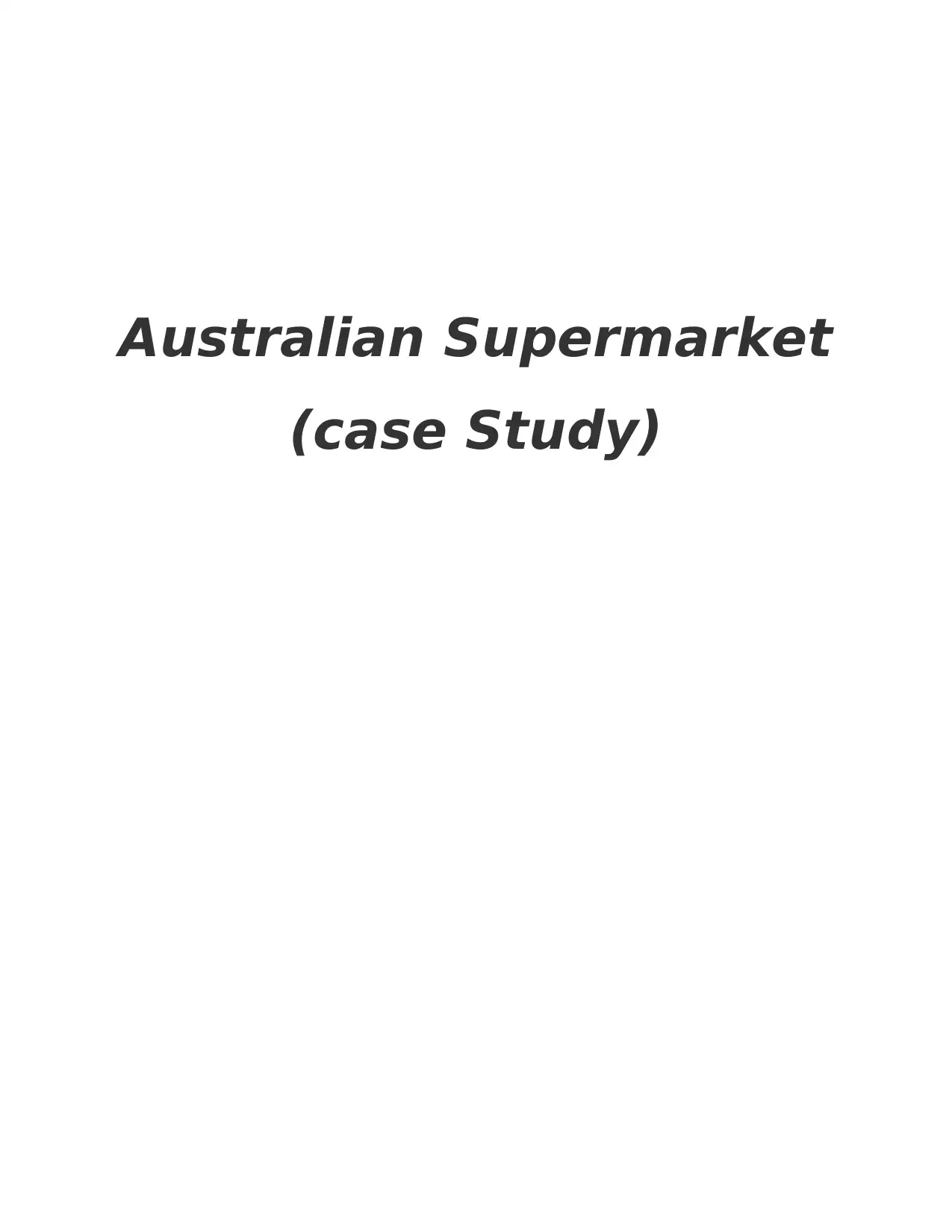
Australian Supermarket
(case Study)
(case Study)
Paraphrase This Document
Need a fresh take? Get an instant paraphrase of this document with our AI Paraphraser
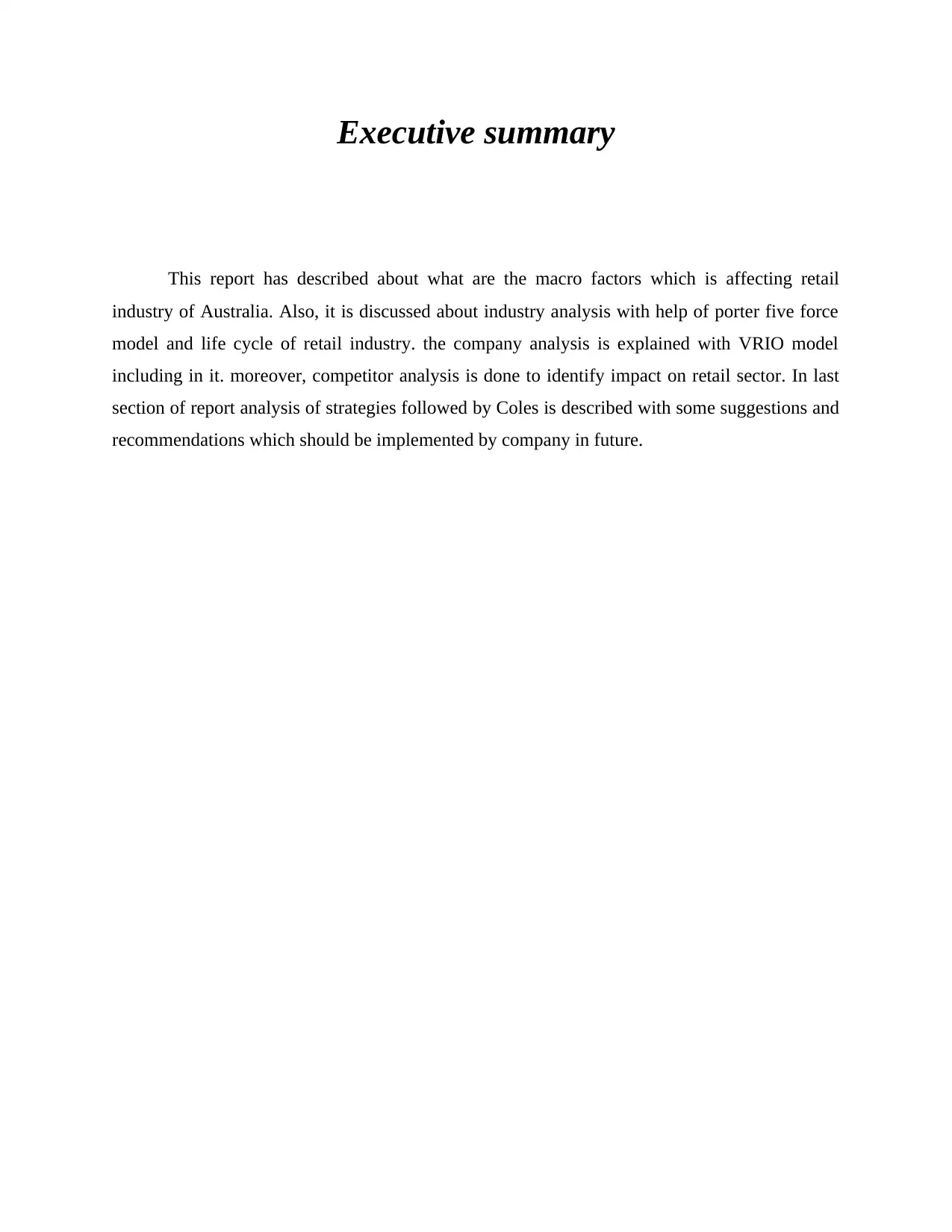
Executive summary
This report has described about what are the macro factors which is affecting retail
industry of Australia. Also, it is discussed about industry analysis with help of porter five force
model and life cycle of retail industry. the company analysis is explained with VRIO model
including in it. moreover, competitor analysis is done to identify impact on retail sector. In last
section of report analysis of strategies followed by Coles is described with some suggestions and
recommendations which should be implemented by company in future.
This report has described about what are the macro factors which is affecting retail
industry of Australia. Also, it is discussed about industry analysis with help of porter five force
model and life cycle of retail industry. the company analysis is explained with VRIO model
including in it. moreover, competitor analysis is done to identify impact on retail sector. In last
section of report analysis of strategies followed by Coles is described with some suggestions and
recommendations which should be implemented by company in future.
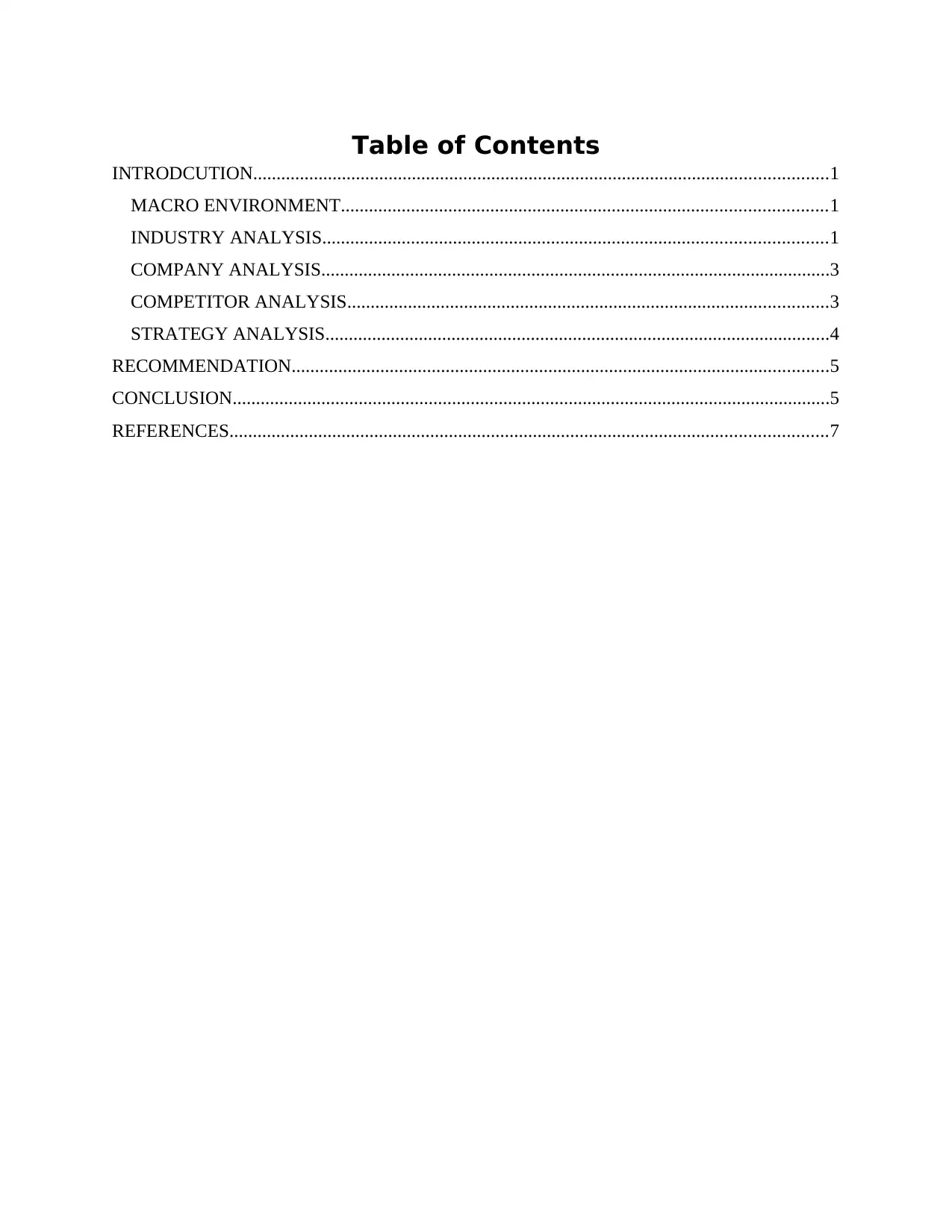
Table of Contents
INTRODCUTION...........................................................................................................................1
MACRO ENVIRONMENT........................................................................................................1
INDUSTRY ANALYSIS............................................................................................................1
COMPANY ANALYSIS.............................................................................................................3
COMPETITOR ANALYSIS.......................................................................................................3
STRATEGY ANALYSIS............................................................................................................4
RECOMMENDATION...................................................................................................................5
CONCLUSION................................................................................................................................5
REFERENCES................................................................................................................................7
INTRODCUTION...........................................................................................................................1
MACRO ENVIRONMENT........................................................................................................1
INDUSTRY ANALYSIS............................................................................................................1
COMPANY ANALYSIS.............................................................................................................3
COMPETITOR ANALYSIS.......................................................................................................3
STRATEGY ANALYSIS............................................................................................................4
RECOMMENDATION...................................................................................................................5
CONCLUSION................................................................................................................................5
REFERENCES................................................................................................................................7
⊘ This is a preview!⊘
Do you want full access?
Subscribe today to unlock all pages.

Trusted by 1+ million students worldwide
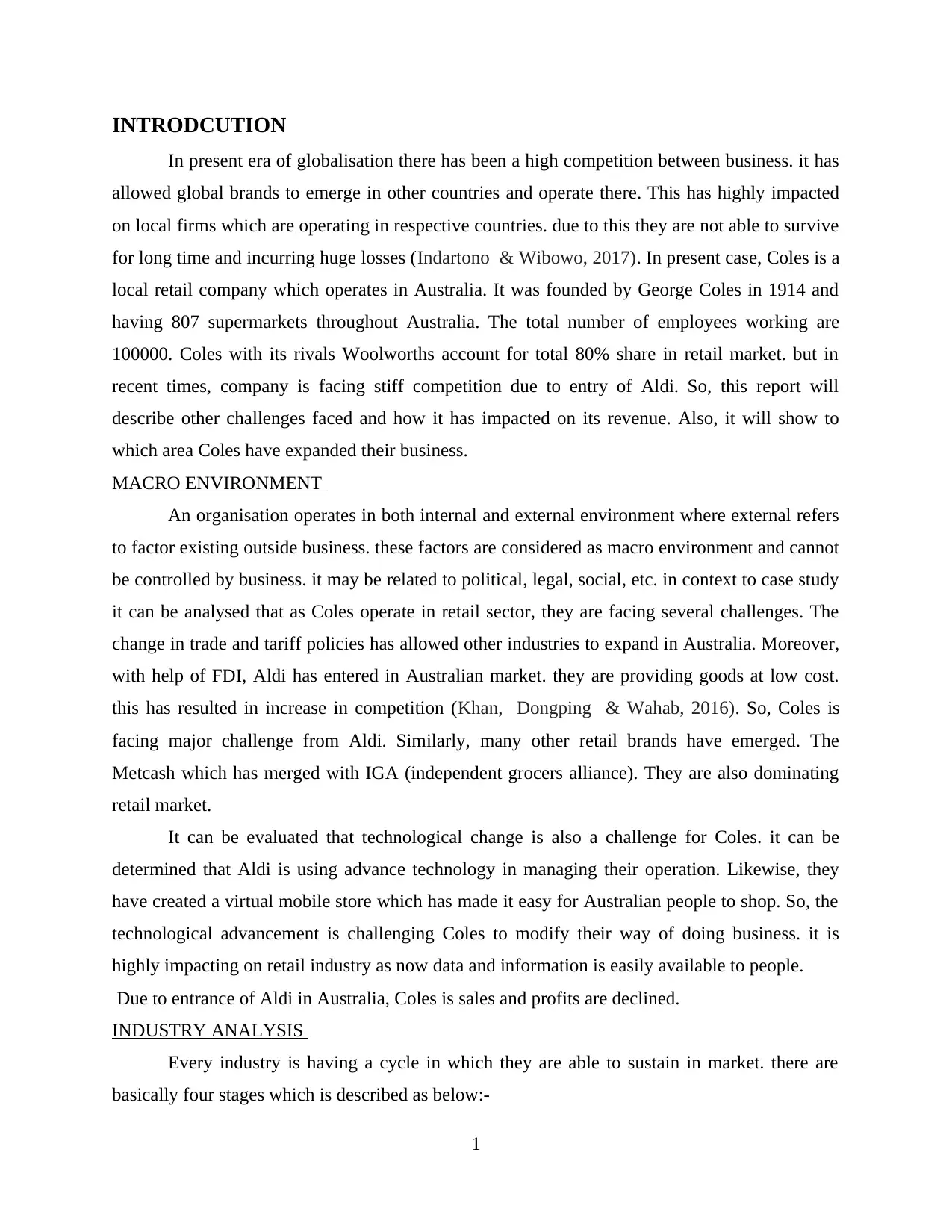
INTRODCUTION
In present era of globalisation there has been a high competition between business. it has
allowed global brands to emerge in other countries and operate there. This has highly impacted
on local firms which are operating in respective countries. due to this they are not able to survive
for long time and incurring huge losses (Indartono & Wibowo, 2017). In present case, Coles is a
local retail company which operates in Australia. It was founded by George Coles in 1914 and
having 807 supermarkets throughout Australia. The total number of employees working are
100000. Coles with its rivals Woolworths account for total 80% share in retail market. but in
recent times, company is facing stiff competition due to entry of Aldi. So, this report will
describe other challenges faced and how it has impacted on its revenue. Also, it will show to
which area Coles have expanded their business.
MACRO ENVIRONMENT
An organisation operates in both internal and external environment where external refers
to factor existing outside business. these factors are considered as macro environment and cannot
be controlled by business. it may be related to political, legal, social, etc. in context to case study
it can be analysed that as Coles operate in retail sector, they are facing several challenges. The
change in trade and tariff policies has allowed other industries to expand in Australia. Moreover,
with help of FDI, Aldi has entered in Australian market. they are providing goods at low cost.
this has resulted in increase in competition (Khan, Dongping & Wahab, 2016). So, Coles is
facing major challenge from Aldi. Similarly, many other retail brands have emerged. The
Metcash which has merged with IGA (independent grocers alliance). They are also dominating
retail market.
It can be evaluated that technological change is also a challenge for Coles. it can be
determined that Aldi is using advance technology in managing their operation. Likewise, they
have created a virtual mobile store which has made it easy for Australian people to shop. So, the
technological advancement is challenging Coles to modify their way of doing business. it is
highly impacting on retail industry as now data and information is easily available to people.
Due to entrance of Aldi in Australia, Coles is sales and profits are declined.
INDUSTRY ANALYSIS
Every industry is having a cycle in which they are able to sustain in market. there are
basically four stages which is described as below:-
1
In present era of globalisation there has been a high competition between business. it has
allowed global brands to emerge in other countries and operate there. This has highly impacted
on local firms which are operating in respective countries. due to this they are not able to survive
for long time and incurring huge losses (Indartono & Wibowo, 2017). In present case, Coles is a
local retail company which operates in Australia. It was founded by George Coles in 1914 and
having 807 supermarkets throughout Australia. The total number of employees working are
100000. Coles with its rivals Woolworths account for total 80% share in retail market. but in
recent times, company is facing stiff competition due to entry of Aldi. So, this report will
describe other challenges faced and how it has impacted on its revenue. Also, it will show to
which area Coles have expanded their business.
MACRO ENVIRONMENT
An organisation operates in both internal and external environment where external refers
to factor existing outside business. these factors are considered as macro environment and cannot
be controlled by business. it may be related to political, legal, social, etc. in context to case study
it can be analysed that as Coles operate in retail sector, they are facing several challenges. The
change in trade and tariff policies has allowed other industries to expand in Australia. Moreover,
with help of FDI, Aldi has entered in Australian market. they are providing goods at low cost.
this has resulted in increase in competition (Khan, Dongping & Wahab, 2016). So, Coles is
facing major challenge from Aldi. Similarly, many other retail brands have emerged. The
Metcash which has merged with IGA (independent grocers alliance). They are also dominating
retail market.
It can be evaluated that technological change is also a challenge for Coles. it can be
determined that Aldi is using advance technology in managing their operation. Likewise, they
have created a virtual mobile store which has made it easy for Australian people to shop. So, the
technological advancement is challenging Coles to modify their way of doing business. it is
highly impacting on retail industry as now data and information is easily available to people.
Due to entrance of Aldi in Australia, Coles is sales and profits are declined.
INDUSTRY ANALYSIS
Every industry is having a cycle in which they are able to sustain in market. there are
basically four stages which is described as below:-
1
Paraphrase This Document
Need a fresh take? Get an instant paraphrase of this document with our AI Paraphraser
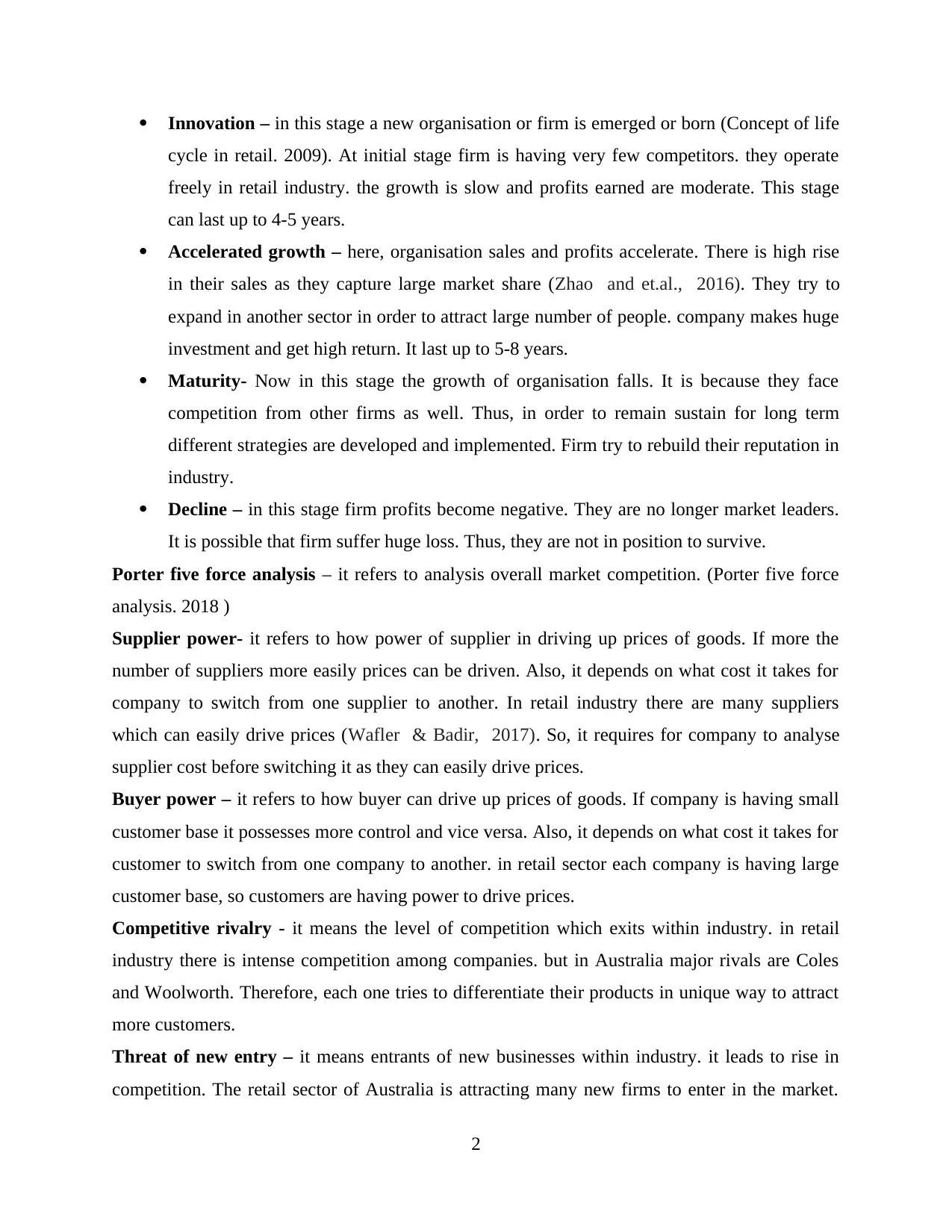
Innovation – in this stage a new organisation or firm is emerged or born (Concept of life
cycle in retail. 2009). At initial stage firm is having very few competitors. they operate
freely in retail industry. the growth is slow and profits earned are moderate. This stage
can last up to 4-5 years.
Accelerated growth – here, organisation sales and profits accelerate. There is high rise
in their sales as they capture large market share (Zhao and et.al., 2016). They try to
expand in another sector in order to attract large number of people. company makes huge
investment and get high return. It last up to 5-8 years.
Maturity- Now in this stage the growth of organisation falls. It is because they face
competition from other firms as well. Thus, in order to remain sustain for long term
different strategies are developed and implemented. Firm try to rebuild their reputation in
industry.
Decline – in this stage firm profits become negative. They are no longer market leaders.
It is possible that firm suffer huge loss. Thus, they are not in position to survive.
Porter five force analysis – it refers to analysis overall market competition. (Porter five force
analysis. 2018 )
Supplier power- it refers to how power of supplier in driving up prices of goods. If more the
number of suppliers more easily prices can be driven. Also, it depends on what cost it takes for
company to switch from one supplier to another. In retail industry there are many suppliers
which can easily drive prices (Wafler & Badir, 2017). So, it requires for company to analyse
supplier cost before switching it as they can easily drive prices.
Buyer power – it refers to how buyer can drive up prices of goods. If company is having small
customer base it possesses more control and vice versa. Also, it depends on what cost it takes for
customer to switch from one company to another. in retail sector each company is having large
customer base, so customers are having power to drive prices.
Competitive rivalry - it means the level of competition which exits within industry. in retail
industry there is intense competition among companies. but in Australia major rivals are Coles
and Woolworth. Therefore, each one tries to differentiate their products in unique way to attract
more customers.
Threat of new entry – it means entrants of new businesses within industry. it leads to rise in
competition. The retail sector of Australia is attracting many new firms to enter in the market.
2
cycle in retail. 2009). At initial stage firm is having very few competitors. they operate
freely in retail industry. the growth is slow and profits earned are moderate. This stage
can last up to 4-5 years.
Accelerated growth – here, organisation sales and profits accelerate. There is high rise
in their sales as they capture large market share (Zhao and et.al., 2016). They try to
expand in another sector in order to attract large number of people. company makes huge
investment and get high return. It last up to 5-8 years.
Maturity- Now in this stage the growth of organisation falls. It is because they face
competition from other firms as well. Thus, in order to remain sustain for long term
different strategies are developed and implemented. Firm try to rebuild their reputation in
industry.
Decline – in this stage firm profits become negative. They are no longer market leaders.
It is possible that firm suffer huge loss. Thus, they are not in position to survive.
Porter five force analysis – it refers to analysis overall market competition. (Porter five force
analysis. 2018 )
Supplier power- it refers to how power of supplier in driving up prices of goods. If more the
number of suppliers more easily prices can be driven. Also, it depends on what cost it takes for
company to switch from one supplier to another. In retail industry there are many suppliers
which can easily drive prices (Wafler & Badir, 2017). So, it requires for company to analyse
supplier cost before switching it as they can easily drive prices.
Buyer power – it refers to how buyer can drive up prices of goods. If company is having small
customer base it possesses more control and vice versa. Also, it depends on what cost it takes for
customer to switch from one company to another. in retail sector each company is having large
customer base, so customers are having power to drive prices.
Competitive rivalry - it means the level of competition which exits within industry. in retail
industry there is intense competition among companies. but in Australia major rivals are Coles
and Woolworth. Therefore, each one tries to differentiate their products in unique way to attract
more customers.
Threat of new entry – it means entrants of new businesses within industry. it leads to rise in
competition. The retail sector of Australia is attracting many new firms to enter in the market.
2
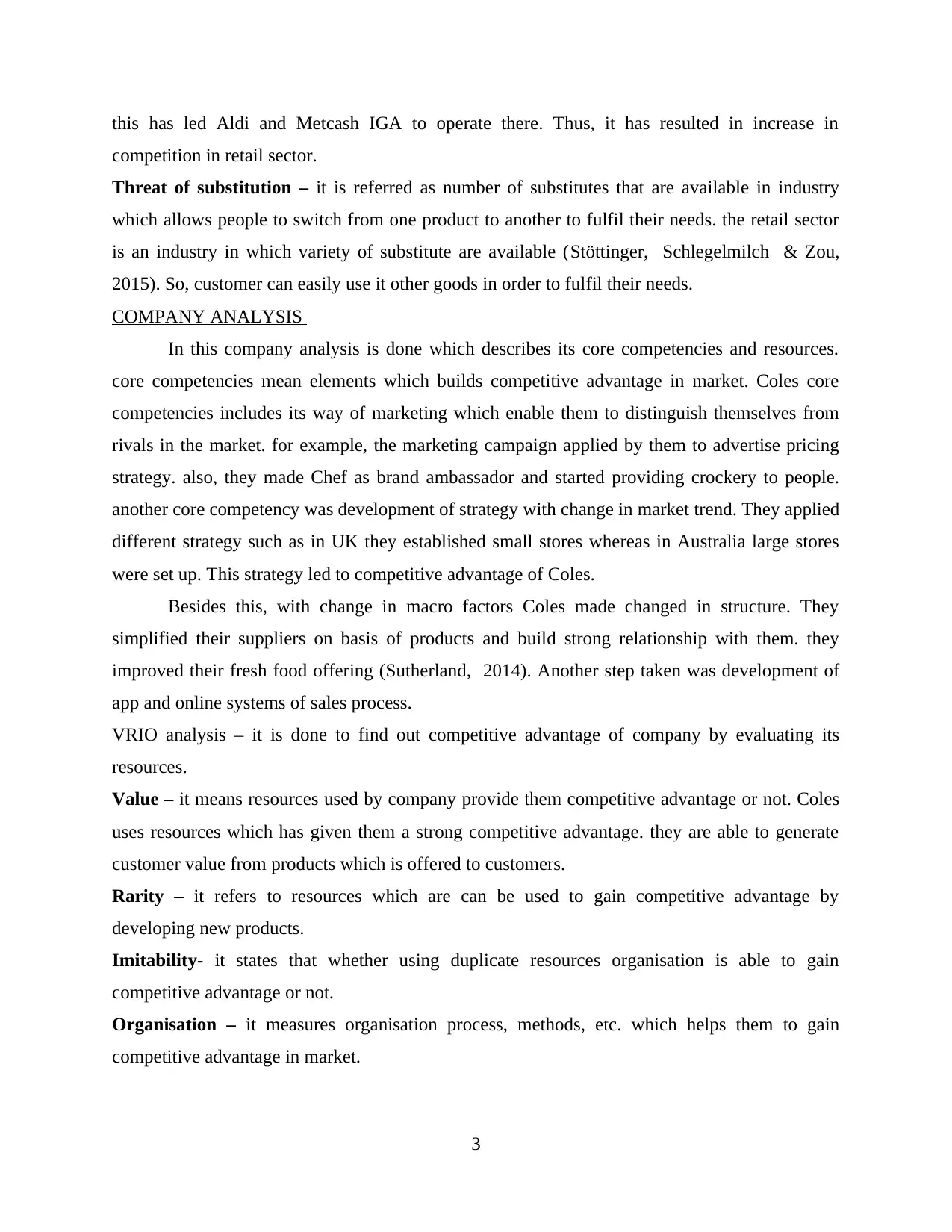
this has led Aldi and Metcash IGA to operate there. Thus, it has resulted in increase in
competition in retail sector.
Threat of substitution – it is referred as number of substitutes that are available in industry
which allows people to switch from one product to another to fulfil their needs. the retail sector
is an industry in which variety of substitute are available (Stöttinger, Schlegelmilch & Zou,
2015). So, customer can easily use it other goods in order to fulfil their needs.
COMPANY ANALYSIS
In this company analysis is done which describes its core competencies and resources.
core competencies mean elements which builds competitive advantage in market. Coles core
competencies includes its way of marketing which enable them to distinguish themselves from
rivals in the market. for example, the marketing campaign applied by them to advertise pricing
strategy. also, they made Chef as brand ambassador and started providing crockery to people.
another core competency was development of strategy with change in market trend. They applied
different strategy such as in UK they established small stores whereas in Australia large stores
were set up. This strategy led to competitive advantage of Coles.
Besides this, with change in macro factors Coles made changed in structure. They
simplified their suppliers on basis of products and build strong relationship with them. they
improved their fresh food offering (Sutherland, 2014). Another step taken was development of
app and online systems of sales process.
VRIO analysis – it is done to find out competitive advantage of company by evaluating its
resources.
Value – it means resources used by company provide them competitive advantage or not. Coles
uses resources which has given them a strong competitive advantage. they are able to generate
customer value from products which is offered to customers.
Rarity – it refers to resources which are can be used to gain competitive advantage by
developing new products.
Imitability- it states that whether using duplicate resources organisation is able to gain
competitive advantage or not.
Organisation – it measures organisation process, methods, etc. which helps them to gain
competitive advantage in market.
3
competition in retail sector.
Threat of substitution – it is referred as number of substitutes that are available in industry
which allows people to switch from one product to another to fulfil their needs. the retail sector
is an industry in which variety of substitute are available (Stöttinger, Schlegelmilch & Zou,
2015). So, customer can easily use it other goods in order to fulfil their needs.
COMPANY ANALYSIS
In this company analysis is done which describes its core competencies and resources.
core competencies mean elements which builds competitive advantage in market. Coles core
competencies includes its way of marketing which enable them to distinguish themselves from
rivals in the market. for example, the marketing campaign applied by them to advertise pricing
strategy. also, they made Chef as brand ambassador and started providing crockery to people.
another core competency was development of strategy with change in market trend. They applied
different strategy such as in UK they established small stores whereas in Australia large stores
were set up. This strategy led to competitive advantage of Coles.
Besides this, with change in macro factors Coles made changed in structure. They
simplified their suppliers on basis of products and build strong relationship with them. they
improved their fresh food offering (Sutherland, 2014). Another step taken was development of
app and online systems of sales process.
VRIO analysis – it is done to find out competitive advantage of company by evaluating its
resources.
Value – it means resources used by company provide them competitive advantage or not. Coles
uses resources which has given them a strong competitive advantage. they are able to generate
customer value from products which is offered to customers.
Rarity – it refers to resources which are can be used to gain competitive advantage by
developing new products.
Imitability- it states that whether using duplicate resources organisation is able to gain
competitive advantage or not.
Organisation – it measures organisation process, methods, etc. which helps them to gain
competitive advantage in market.
3
⊘ This is a preview!⊘
Do you want full access?
Subscribe today to unlock all pages.

Trusted by 1+ million students worldwide
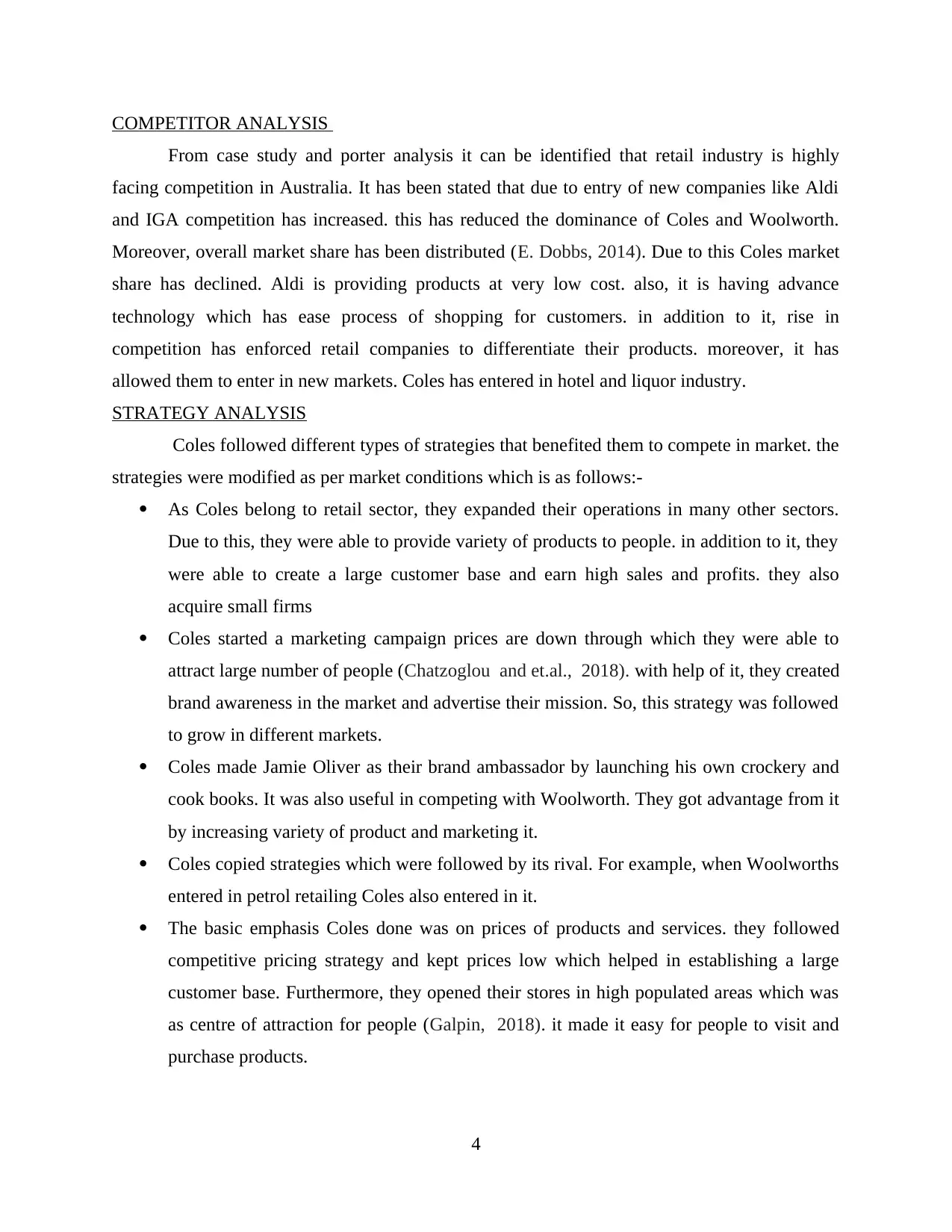
COMPETITOR ANALYSIS
From case study and porter analysis it can be identified that retail industry is highly
facing competition in Australia. It has been stated that due to entry of new companies like Aldi
and IGA competition has increased. this has reduced the dominance of Coles and Woolworth.
Moreover, overall market share has been distributed (E. Dobbs, 2014). Due to this Coles market
share has declined. Aldi is providing products at very low cost. also, it is having advance
technology which has ease process of shopping for customers. in addition to it, rise in
competition has enforced retail companies to differentiate their products. moreover, it has
allowed them to enter in new markets. Coles has entered in hotel and liquor industry.
STRATEGY ANALYSIS
Coles followed different types of strategies that benefited them to compete in market. the
strategies were modified as per market conditions which is as follows:-
As Coles belong to retail sector, they expanded their operations in many other sectors.
Due to this, they were able to provide variety of products to people. in addition to it, they
were able to create a large customer base and earn high sales and profits. they also
acquire small firms
Coles started a marketing campaign prices are down through which they were able to
attract large number of people (Chatzoglou and et.al., 2018). with help of it, they created
brand awareness in the market and advertise their mission. So, this strategy was followed
to grow in different markets.
Coles made Jamie Oliver as their brand ambassador by launching his own crockery and
cook books. It was also useful in competing with Woolworth. They got advantage from it
by increasing variety of product and marketing it.
Coles copied strategies which were followed by its rival. For example, when Woolworths
entered in petrol retailing Coles also entered in it.
The basic emphasis Coles done was on prices of products and services. they followed
competitive pricing strategy and kept prices low which helped in establishing a large
customer base. Furthermore, they opened their stores in high populated areas which was
as centre of attraction for people (Galpin, 2018). it made it easy for people to visit and
purchase products.
4
From case study and porter analysis it can be identified that retail industry is highly
facing competition in Australia. It has been stated that due to entry of new companies like Aldi
and IGA competition has increased. this has reduced the dominance of Coles and Woolworth.
Moreover, overall market share has been distributed (E. Dobbs, 2014). Due to this Coles market
share has declined. Aldi is providing products at very low cost. also, it is having advance
technology which has ease process of shopping for customers. in addition to it, rise in
competition has enforced retail companies to differentiate their products. moreover, it has
allowed them to enter in new markets. Coles has entered in hotel and liquor industry.
STRATEGY ANALYSIS
Coles followed different types of strategies that benefited them to compete in market. the
strategies were modified as per market conditions which is as follows:-
As Coles belong to retail sector, they expanded their operations in many other sectors.
Due to this, they were able to provide variety of products to people. in addition to it, they
were able to create a large customer base and earn high sales and profits. they also
acquire small firms
Coles started a marketing campaign prices are down through which they were able to
attract large number of people (Chatzoglou and et.al., 2018). with help of it, they created
brand awareness in the market and advertise their mission. So, this strategy was followed
to grow in different markets.
Coles made Jamie Oliver as their brand ambassador by launching his own crockery and
cook books. It was also useful in competing with Woolworth. They got advantage from it
by increasing variety of product and marketing it.
Coles copied strategies which were followed by its rival. For example, when Woolworths
entered in petrol retailing Coles also entered in it.
The basic emphasis Coles done was on prices of products and services. they followed
competitive pricing strategy and kept prices low which helped in establishing a large
customer base. Furthermore, they opened their stores in high populated areas which was
as centre of attraction for people (Galpin, 2018). it made it easy for people to visit and
purchase products.
4
Paraphrase This Document
Need a fresh take? Get an instant paraphrase of this document with our AI Paraphraser
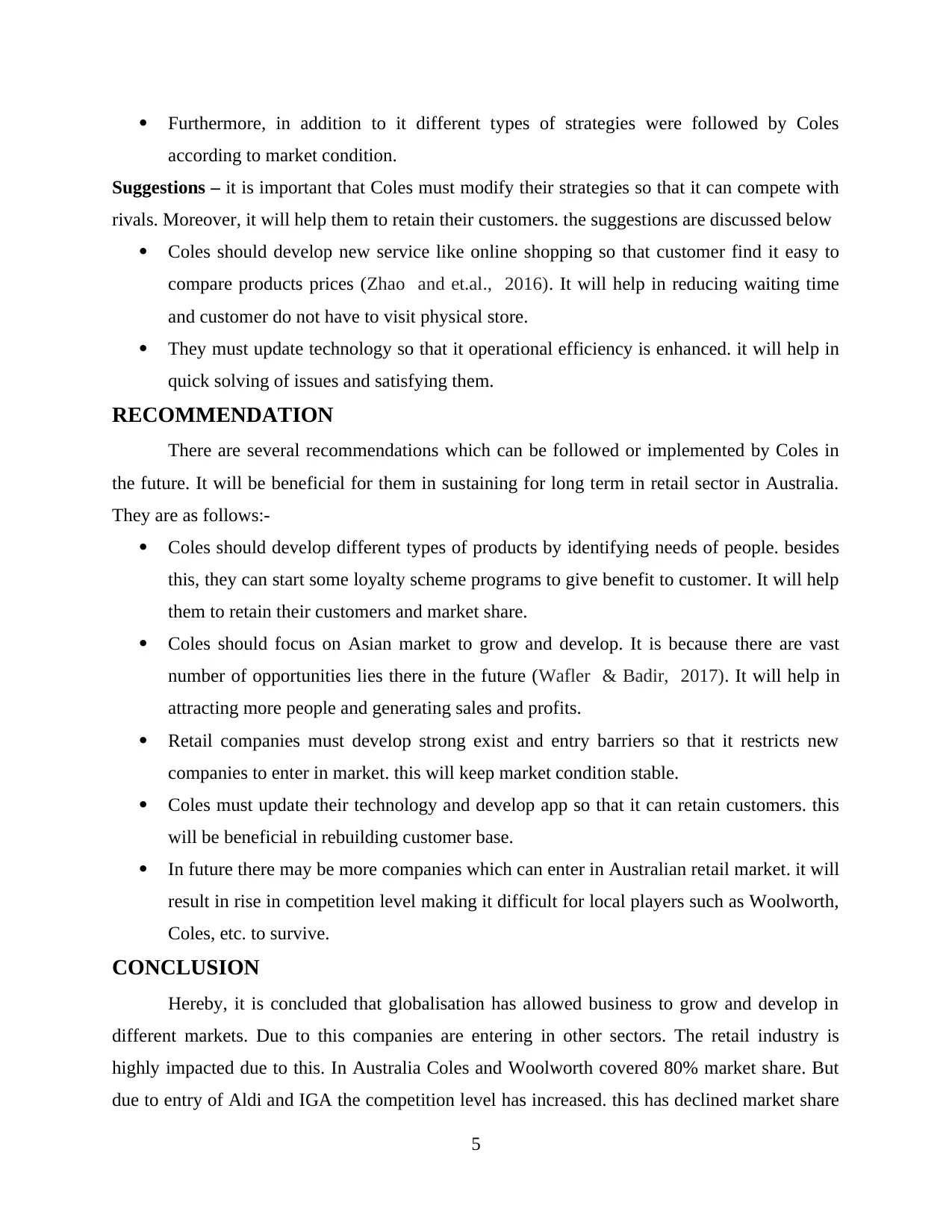
Furthermore, in addition to it different types of strategies were followed by Coles
according to market condition.
Suggestions – it is important that Coles must modify their strategies so that it can compete with
rivals. Moreover, it will help them to retain their customers. the suggestions are discussed below
Coles should develop new service like online shopping so that customer find it easy to
compare products prices (Zhao and et.al., 2016). It will help in reducing waiting time
and customer do not have to visit physical store.
They must update technology so that it operational efficiency is enhanced. it will help in
quick solving of issues and satisfying them.
RECOMMENDATION
There are several recommendations which can be followed or implemented by Coles in
the future. It will be beneficial for them in sustaining for long term in retail sector in Australia.
They are as follows:-
Coles should develop different types of products by identifying needs of people. besides
this, they can start some loyalty scheme programs to give benefit to customer. It will help
them to retain their customers and market share.
Coles should focus on Asian market to grow and develop. It is because there are vast
number of opportunities lies there in the future (Wafler & Badir, 2017). It will help in
attracting more people and generating sales and profits.
Retail companies must develop strong exist and entry barriers so that it restricts new
companies to enter in market. this will keep market condition stable.
Coles must update their technology and develop app so that it can retain customers. this
will be beneficial in rebuilding customer base.
In future there may be more companies which can enter in Australian retail market. it will
result in rise in competition level making it difficult for local players such as Woolworth,
Coles, etc. to survive.
CONCLUSION
Hereby, it is concluded that globalisation has allowed business to grow and develop in
different markets. Due to this companies are entering in other sectors. The retail industry is
highly impacted due to this. In Australia Coles and Woolworth covered 80% market share. But
due to entry of Aldi and IGA the competition level has increased. this has declined market share
5
according to market condition.
Suggestions – it is important that Coles must modify their strategies so that it can compete with
rivals. Moreover, it will help them to retain their customers. the suggestions are discussed below
Coles should develop new service like online shopping so that customer find it easy to
compare products prices (Zhao and et.al., 2016). It will help in reducing waiting time
and customer do not have to visit physical store.
They must update technology so that it operational efficiency is enhanced. it will help in
quick solving of issues and satisfying them.
RECOMMENDATION
There are several recommendations which can be followed or implemented by Coles in
the future. It will be beneficial for them in sustaining for long term in retail sector in Australia.
They are as follows:-
Coles should develop different types of products by identifying needs of people. besides
this, they can start some loyalty scheme programs to give benefit to customer. It will help
them to retain their customers and market share.
Coles should focus on Asian market to grow and develop. It is because there are vast
number of opportunities lies there in the future (Wafler & Badir, 2017). It will help in
attracting more people and generating sales and profits.
Retail companies must develop strong exist and entry barriers so that it restricts new
companies to enter in market. this will keep market condition stable.
Coles must update their technology and develop app so that it can retain customers. this
will be beneficial in rebuilding customer base.
In future there may be more companies which can enter in Australian retail market. it will
result in rise in competition level making it difficult for local players such as Woolworth,
Coles, etc. to survive.
CONCLUSION
Hereby, it is concluded that globalisation has allowed business to grow and develop in
different markets. Due to this companies are entering in other sectors. The retail industry is
highly impacted due to this. In Australia Coles and Woolworth covered 80% market share. But
due to entry of Aldi and IGA the competition level has increased. this has declined market share
5
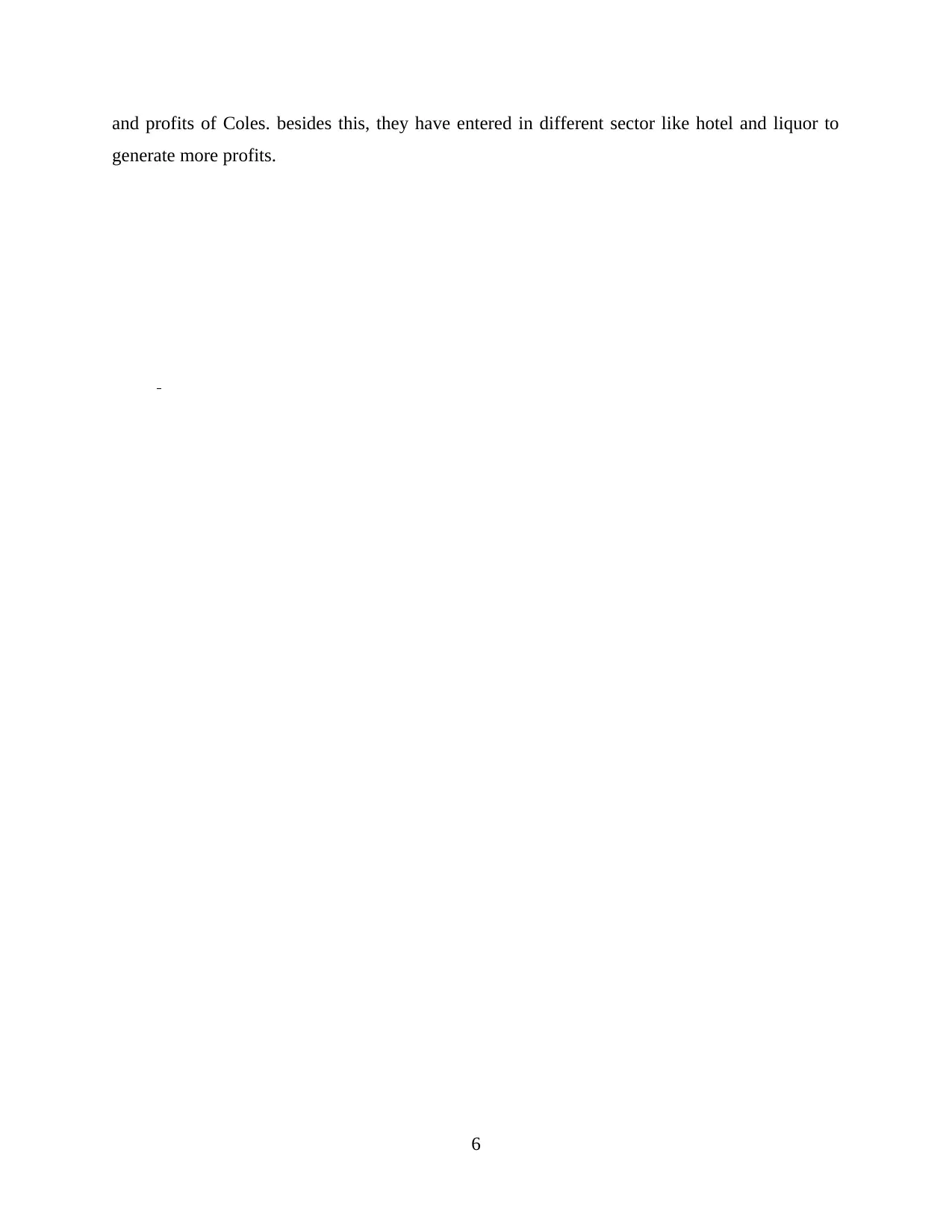
and profits of Coles. besides this, they have entered in different sector like hotel and liquor to
generate more profits.
6
generate more profits.
6
⊘ This is a preview!⊘
Do you want full access?
Subscribe today to unlock all pages.

Trusted by 1+ million students worldwide
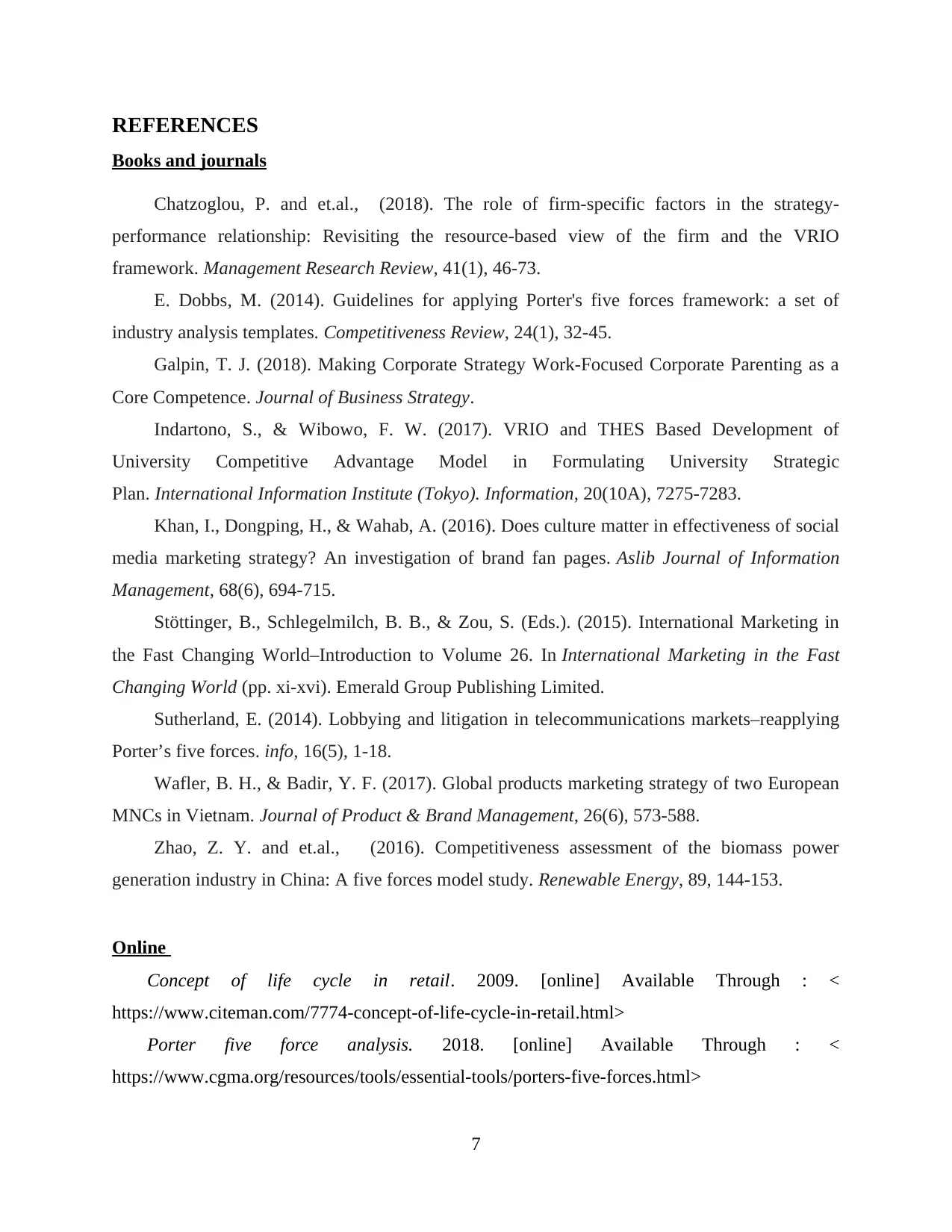
REFERENCES
Books and journals
Chatzoglou, P. and et.al., (2018). The role of firm-specific factors in the strategy-
performance relationship: Revisiting the resource-based view of the firm and the VRIO
framework. Management Research Review, 41(1), 46-73.
E. Dobbs, M. (2014). Guidelines for applying Porter's five forces framework: a set of
industry analysis templates. Competitiveness Review, 24(1), 32-45.
Galpin, T. J. (2018). Making Corporate Strategy Work-Focused Corporate Parenting as a
Core Competence. Journal of Business Strategy.
Indartono, S., & Wibowo, F. W. (2017). VRIO and THES Based Development of
University Competitive Advantage Model in Formulating University Strategic
Plan. International Information Institute (Tokyo). Information, 20(10A), 7275-7283.
Khan, I., Dongping, H., & Wahab, A. (2016). Does culture matter in effectiveness of social
media marketing strategy? An investigation of brand fan pages. Aslib Journal of Information
Management, 68(6), 694-715.
Stöttinger, B., Schlegelmilch, B. B., & Zou, S. (Eds.). (2015). International Marketing in
the Fast Changing World–Introduction to Volume 26. In International Marketing in the Fast
Changing World (pp. xi-xvi). Emerald Group Publishing Limited.
Sutherland, E. (2014). Lobbying and litigation in telecommunications markets–reapplying
Porter’s five forces. info, 16(5), 1-18.
Wafler, B. H., & Badir, Y. F. (2017). Global products marketing strategy of two European
MNCs in Vietnam. Journal of Product & Brand Management, 26(6), 573-588.
Zhao, Z. Y. and et.al., (2016). Competitiveness assessment of the biomass power
generation industry in China: A five forces model study. Renewable Energy, 89, 144-153.
Online
Concept of life cycle in retail. 2009. [online] Available Through : <
https://www.citeman.com/7774-concept-of-life-cycle-in-retail.html>
Porter five force analysis. 2018. [online] Available Through : <
https://www.cgma.org/resources/tools/essential-tools/porters-five-forces.html>
7
Books and journals
Chatzoglou, P. and et.al., (2018). The role of firm-specific factors in the strategy-
performance relationship: Revisiting the resource-based view of the firm and the VRIO
framework. Management Research Review, 41(1), 46-73.
E. Dobbs, M. (2014). Guidelines for applying Porter's five forces framework: a set of
industry analysis templates. Competitiveness Review, 24(1), 32-45.
Galpin, T. J. (2018). Making Corporate Strategy Work-Focused Corporate Parenting as a
Core Competence. Journal of Business Strategy.
Indartono, S., & Wibowo, F. W. (2017). VRIO and THES Based Development of
University Competitive Advantage Model in Formulating University Strategic
Plan. International Information Institute (Tokyo). Information, 20(10A), 7275-7283.
Khan, I., Dongping, H., & Wahab, A. (2016). Does culture matter in effectiveness of social
media marketing strategy? An investigation of brand fan pages. Aslib Journal of Information
Management, 68(6), 694-715.
Stöttinger, B., Schlegelmilch, B. B., & Zou, S. (Eds.). (2015). International Marketing in
the Fast Changing World–Introduction to Volume 26. In International Marketing in the Fast
Changing World (pp. xi-xvi). Emerald Group Publishing Limited.
Sutherland, E. (2014). Lobbying and litigation in telecommunications markets–reapplying
Porter’s five forces. info, 16(5), 1-18.
Wafler, B. H., & Badir, Y. F. (2017). Global products marketing strategy of two European
MNCs in Vietnam. Journal of Product & Brand Management, 26(6), 573-588.
Zhao, Z. Y. and et.al., (2016). Competitiveness assessment of the biomass power
generation industry in China: A five forces model study. Renewable Energy, 89, 144-153.
Online
Concept of life cycle in retail. 2009. [online] Available Through : <
https://www.citeman.com/7774-concept-of-life-cycle-in-retail.html>
Porter five force analysis. 2018. [online] Available Through : <
https://www.cgma.org/resources/tools/essential-tools/porters-five-forces.html>
7
Paraphrase This Document
Need a fresh take? Get an instant paraphrase of this document with our AI Paraphraser

8
1 out of 11
Related Documents
Your All-in-One AI-Powered Toolkit for Academic Success.
+13062052269
info@desklib.com
Available 24*7 on WhatsApp / Email
![[object Object]](/_next/static/media/star-bottom.7253800d.svg)
Unlock your academic potential
Copyright © 2020–2025 A2Z Services. All Rights Reserved. Developed and managed by ZUCOL.


